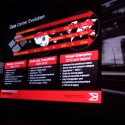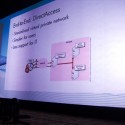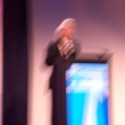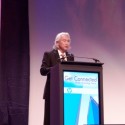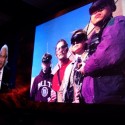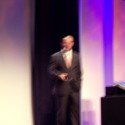Closing Keynote Live Blog – HP Tech Forum 2009
HP has a great closing session for you.
Master of Ceremonies: Bill Sales: VP – Industry Standard Servers – Americas
Mike Klayko: CEO – Brocade
Rob Helm: Director of Research on Microsoft – Independent Analysis of MS Tech & Strategy.
Tom Kilroy: VP – GM Intel Digital Enterprise Group
Dr. Michael Kaku: Henry Semat Chair in Theoretical Physics, City University of New York.
—-
3:20 PM: Event Starts. Bill Sales introduces and tells participants whomever guesses the registration attendance can win backstage passes to the Beach Boys in the evening.
3:30 PM: Mike Klayko from Brocade takes the stage. Mike starts off talking about Roz Savage and how Brocade supports her efforts. He then talked about the acquisitions they have made. Data Center Transition is the next subject. The cost change in the last year was dramatic.
Standards will change to put everything into the cloud. Convergence will come into play in the Data Center. Brocade will be deploying Converged Technologies.
Evolution: 15 Billion devices will be deployed in the years. In the Campus – A Network Evolution will occur. You will be able to roam across campuses without interruption.
3:48 PM: Quick Video from Brocade
Choice, Solutions and Savings are the three focuses Mike wants to convey. www.brocade.com/technologyday for more information on these three.
3:51 PM: Rob Helm takes the stage. He talkes about On Time Software Releases (in jest). He states the next 12 months will be “Interesting” for Microsoft. Windows 7, Server 2008, Office 2010, SharePoint and Exchange 2010 and Communications Server 2010.
Rob creates the “Enterprise Software RoadMap, which includes releases and retirements, then a best guess of the future. Rob says this next year will be Microsofts’ busiest than ever.
Rob states Windows 7 is available on Oct 22, Server 2008 R2 around that same time. The idea of moving from “Old to New”. There will be some push factors, but also Pull factors.
He goes on to show a timeline from XP to Windows 7. He states this is an Incremental release and believes Windows 7 will be the first to put the system on a shared core with the Server OS for the first time since Windows 2000.
Direct Access – like a VPN – to connect to and work. The difference is if the user is out of compliance, Windows Server will manage the client to put the user back to compliance.
End to End: BranchCache – File Caching for branch offices. It will improve network performance and simplify management. The clients manage the files between one another.
Rob then goes into the real advantages of upgrading to Windows 7 and Server 2008. Virtualization is the big one. It cuts down on costs and bandwidth. Virtual Machines that will have failure redundancy with a seamless transition. Load balancing and maintenance schedules will also be big advantages. But as Rob says – If a death ray zaps your server….
Scalability, Managability and Availability are the 3 things in a HP – MS central partnership. Rob believes that HP customers will be in the “Front Row” to the future.
4:12 PM: Tom Kilroy comes up about IT Pains, the Intel Advantage and what it means to us.
Old Age: The longer you hold on to something, the more it’s gonna cost in the long run. By year 3-4, the studies show PC costs go up 33% , then 40% after year 4. A 4 year server will need more wattage than a 2 year old server.
80% of IT spends – 30% Operating and 50% Expense. Data Centers are on track to consuming up to 3% of all US Electricity use. System improvements are helping keep us out of that 3% mark.
People and Virtualization. Tom notes from IDC: “Client-side virtualization will outpace server-hosted desktops by almost 2x by 2012.” Data Center virtualization will help with those costs both on the server and the client side. One other factor came into play – how to secure the client-side virtualization. Home devices will be allowed more, but IT will have to be able to confirm this will not hurt their systems.
Tom talks about uPro, which will lower power by managing machines that don’t need to be powered on. vPro will show a 10 Month ROI, as oppose to without, which gives a 17 Month ROI.
Tom talks about the Xeon 5500 processor. He quotes the Financial Times as a “Recession Buster”. Chuck comes out and runs a ROI calculator to see how the new computers will save. The answer: 3 months before you see a savings. Dual core machines will show return in 12 months.
4:39 PM: Dr. Michael Kaku came on to talk about the future. He starts by saying that no one is perfect in predicting the future. He talks about how he built his first Atom smasher as a kid. He goes into the book “Physics of the Impossible”. This brings us to Moores Law. Doubling time for computer power in 18 moths.
He reffered to todays birthday cards. If some people had that power 100 years ago – but instead we discard that technology
Michael puts out a challenge to create seamless access to unlimited information, anytime, anywhere.
– Cloud Computing
-Limitation due to speed of light
-Challenge posed by YouTube, Twitter, Facebook and rapidly evolving social networks, etc.
– Computing viewed like a utility
The word Computer will be obsolete. You will use glasses, contacts or brain waves to get information. Cell phones will have “Virtual paper”. Wall screens will help you with tasks like finding a date. Even a computerized dog that doesn’t “Pee on the carpet”.
“Smart Barbie dolls”.
Computers will cost the same as paper. You write on it and discard. Files that follow you. The file itself will be more valuable than the computer.
The Boardroom, the cubicle and the car of the future. DARPA ran a contest. A car was developed that can drive itself. It has been tested on the Autobon.
Mass customization – If you want a $10k channel evening gown, customized to you or the spouse.
Michael talks about the end of Moore’s law. Parallel, Quantum, Optical, DNA and molecular computing are some options. By 2020, chips will have layers 5 atoms across. Molecular transistors could mean that Sillicon Valley could become a “Rust belt”.
3×5=15 was calculated on 5 atoms.Yetnothing has a universal consensus. The age of Silicon must pass.
Another challenge was to reduce biology to computer science. He talks about a smart toilet that will analyze your urine to tell you if you have an issue. Dr. Kaku also talks about a smart pill that can take computers inside a human.
Growing cells into organs. The first Bladder was cloned using your own cells.
Video – Earth in 50 years.
Dr. Kaku says “Aging is error”. By comparing genes, we can work on controlling the process. Alligators and crocadiles don’t get old – they get bigger.
Artificial Intelligence. Why we don’t have AI – They cannot recognize and determine pattern recognition.
Common sense. Water is wet and when you die, you don’t come back. Dr. Kaku asked how you know that? Common sense. Robots do not have the common sense.
He asks “Can AI become dangerous?” The answer: Yes. But control will have to be programmed into the system. Jobs will be lost, but those jobs that are repetitive. Intellectual Capitolizm.
He then repeats the 5 challenges thrown out to everyone.
-Create seamless information anytime, anywhere
-Replace Moores law
– Reduce biology and medicine to computer science
– Solving pattern recognition problem
– Solving common sense problem.
5:20 PM: Dr. Kaku opened it up to questions.
That is the end folks! Beach Boys play later on! Here are some of the pictures of the Keynote.


